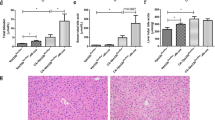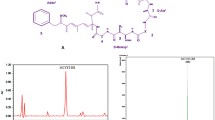Abstract
Phalloidin induces cholestasis by preventing microfilament depolymerization. Phalloidin has been widely used as an agent to induce intrahepatic cholestasis in experimental animals. The objective of this study was to examine the effects of phalloidin on protein expression profiles in mouse liver, so as to identify potential biomarkers of intrahepatic cholestasis. Phalloidin was administered to BALB/c mice at a predetermined dose of 1 mg/kg for 7 days, and phalloidin-induced cholestasis was observed. Hepatic protein expression was investigated via two-dimensional (2D) electrophoresis, and 21 protein spots showing significantly different expression between the treated and control groups were excised from the gels and identified by MALDI-TOF/TOF. The identified proteins were involved in cytoskeletal changes, lipid metabolism, gluconeogenesis, detoxification, and transport mechanisms. Among these proteins, the up-regulation of HSP90-β in phalloidin-treated mice was confirmed by Western blot analysis and then by RT-PCR, indicating that it may serve as a useful biomarker of cholestasis. In summary, these results provide insight into the mechanism involved in phalloidin-induced cytoskeletal change and cholestasis.
Similar content being viewed by others
References
Ishizaki, K. et al. The biochemical studies on phalloidin- induced cholestasis in rats. Toxicol Lett 90:29–34 (1997).
Dancker, P., Low, I., Hasselbach, W. & Wieland, T. Interaction of actin with phalloidin: polymerization and stabilization of F-actin. Biochim Biophys Acta 400:407–414 (1975).
Dubin, M., Maurice, M., Feldmann, G. & Erlinger, S. Influence of colchicine and phalloidin on bile secretion and hepatic ultrastructure in the rat. Possible interaction between microtubules and microfilaments. Gastroenterology 79:646–654 (1980).
Elias, E., Hruban, Z., Wade, J. B. & Boyer, J. L. Phalloidin-induced cholestasis: a microfilament-mediated change in junctional complex permeability. Proc Natl Acad Sci USA 77:2229–2233 (1980).
Vonk, R. J., Yousef, I. M., Corriveau, J. P. & Tuchweber, B. Phalloidin-induced morphological and functional changes of rat liver. Liver 2:133–140 (1982).
Watanabe, S., Miyairi, M., Oshio, C., Smith, C. R. & Phillips, M. J. Phalloidin alters bile canalicular contractility in primary monolayer cultures of rat liver. Gastroenterology 85:245–253 (1983).
Frimmer, M. & Ziegler, K. The transport of bile acids in liver cells. Biochim Biophys Acta 947:75–99 (1988).
Kawaji, A. et al. Effects of mushroom toxins on glycogenolysis; comparison of toxicity of phalloidin, alphaamanitin and DL-propargylglycine in isolated rat hepatocytes. J Pharmacobiodyn 15:107–112 (1992).
Bouchard, G., Yousef, I. M., Barriault, C. & Tuchweber, B. Role of glutathione and oxidative stress in phalloidin-induced cholestasis. J Hepatol 32:550–560 (2000).
Lim, J. S. et al. Effects of phalloidin on hepatic gene expression in mice. Int J Toxicol 26:213–220 (2007).
Wetmore, B. A. & Merrick, B. A. Toxicoproteomics: proteomics applied to toxicology and pathology. Toxicol Pathol 32:619–642 (2004).
Yamamoto, T., Kikkawa, R., Yamada, H. & Horii, I. Investigation of proteomic biomarkers in in vivo hepatotoxicity study of rat liver: toxicity differentiation in hepatotoxicants. J Toxicol Sci 31:49–60 (2006).
Leung, C. L., Green, K. J. & Liem, R. K. Plakins: a family of versatile cytolinker proteins. Trends Cell Biol 12:37–45 (2002).
Leung, C. L., Sun, D., Zheng, M., Knowles, D. R. & Liem, R. K. Microtubule actin cross-linking factor (MACF): a hybrid of dystonin and dystrophin that can interact with the actin and microtubule cytoskeletons. J Cell Biol 147:1275–1286 (1999).
Kodama, A., Karakesisoglou, I., Wong, E., Vaezi, A. & Fuchs, E. ACF7: an essential integrator of microtubule dynamics. Cell 115:343–354 (2003).
Omary, M. B., Ku, N. O. & Toivola, D. M. Keratins: guardians of the liver. Hepatology 35:251–257 (2002).
Herrmann, H., Hesse, M., Reichenzeller, M., Aebi, U. & Magin, T. M. Functional complexity of intermediate filament cytoskeletons: from structure to assembly to gene ablation. Int Rev Cytol 223:83–175 (2003).
Ku, N. O. et al. Keratin 8 and 18 mutations are risk factors for developing liver disease of multiple etiologies. Proc Natl Acad Sci USA 100:6063–6068 (2003).
Toivola, D. M. et al. Keratin 8 and 18 hyperphosphorylation is a marker of progression of human liver disease. Hepatology 40:459–466 (2004).
Zatloukal, K. et al. The keratin cytoskeleton in liver diseases. J Pathol 204:367–376 (2004).
Borghoff, S. J., Short, B. G. & Swenberg, J. A. Biochemical mechanisms and pathobiology of alpha 2u-globulin nephropathy. Annu Rev Pharmacol Toxicol 30:349–367 (1990).
Dominick, M. A. et al. Alpha 2u-globulin nephropathy without nephrocarcinogenesis in male Wistar rats administered 1-(aminomethyl) cyclohexaneacetic acid. Toxicol Appl Pharmacol 111:375–387 (1991).
Kim, S., Qualls, C. W. Jr., Reddy, G. & Stair, E. L. 1,3,5-Trinitrobenzene-induced alpha-2u-globulin nephropathy. Toxicol Pathol 25:195–201 (1997).
Gluckmann, M. et al. Prevalidation of potential protein biomarkers in toxicology using iTRAQ reagent technology. Proteomics 7:1564–1574 (2007).
Horio, F., Kimura, M. & Yoshida, A. Effect of several xenobiotics on the activities of enzymes affecting ascorbic acid synthesis in rats. J Nutr Sci Vitaminol (Tokyo) 29:233–247 (1983).
Craig, E. A., Gambill, B. D. & Nelson, R. J. Heat shock proteins: molecular chaperones of protein biogenesis. Microbiol Rev 57:402–414 (1993).
Kleizen, B. & Braakman, I., Protein folding and quality control in the endoplasmic reticulum. Curr Opin Cell Biol 16:343–349 (2004).
Singh, M. P., Reddy, M. M., Mathur, N., Saxena, D. K. & Chowdhuri, D. K. Induction of hsp70, hsp60, hsp83 and hsp26 and oxidative stress markers in benzene, toluene and xylene exposed Drosophila melanogaster: role of ROS generation. Toxicol Appl Pharmacol 235:226–243 (2009).
Martins, E. B., Chapman, R. W., Marron, K. & Fleming, K. A. Biliary expression of heat shock protein: a non-specific feature of chronic cholestatic liver diseases. J Clin Pathol 49:53–56 (1996).
Sakisaka, S. et al. Ursodeoxycholic acid reduces expression of heat shock proteins in primary biliary cirrhosis. Liver 20:78–87 (2000).
Liang, P. & MacRae, T. H. Molecular chaperones and the cytoskeleton. J Cell Sci 110:1431–1440 (1997).
Yang, G. H., Li, S. & Pestka, J. J. Down-regulation of the endoplasmic reticulum chaperone GRP78/BiP by vomitoxin (Deoxynivalenol). Toxicol Appl Pharmacol 162:207–217 (2000).
Young, J. C., Moarefi, I. & Hartl, F. U. Hsp90: a specialized but essential protein-folding tool. J Cell Biol 154:267–273 (2001).
Antonov, A. et al. Heat shock protein 90 inhibitors protect and restore pulmonary endothelial barrier function. Am J Respir Cell Mol Biol 39:551–559 (2008).
Choi, B. K., Cho, Y. M., Bae, S. H., Zoubaulis, C. C. & Paik, Y. K. Single-step perfusion chromatography with a throughput potential for enhanced peptide detection by matrix-assisted laser desorption/ionization-mass spectrometry. Proteomics 3:1955–1961 (2003).
Author information
Authors and Affiliations
Corresponding authors
Rights and permissions
About this article
Cite this article
Heo, S.H., Oh, JH., Park, HJ. et al. Toxicoproteomic analysis of phalloidin-induced cholestasis in mouse liver. Mol. Cell. Toxicol. 6, 87–95 (2010). https://doi.org/10.1007/s13273-010-0012-7
Received:
Accepted:
Published:
Issue Date:
DOI: https://doi.org/10.1007/s13273-010-0012-7




